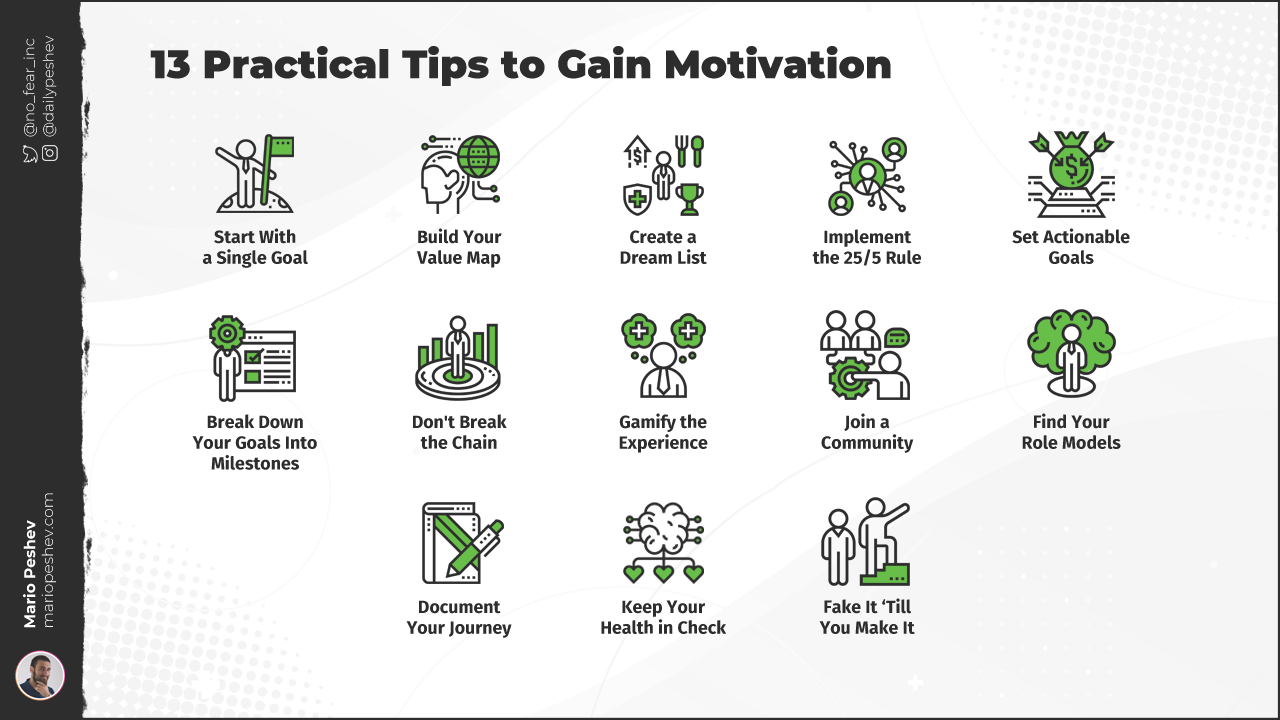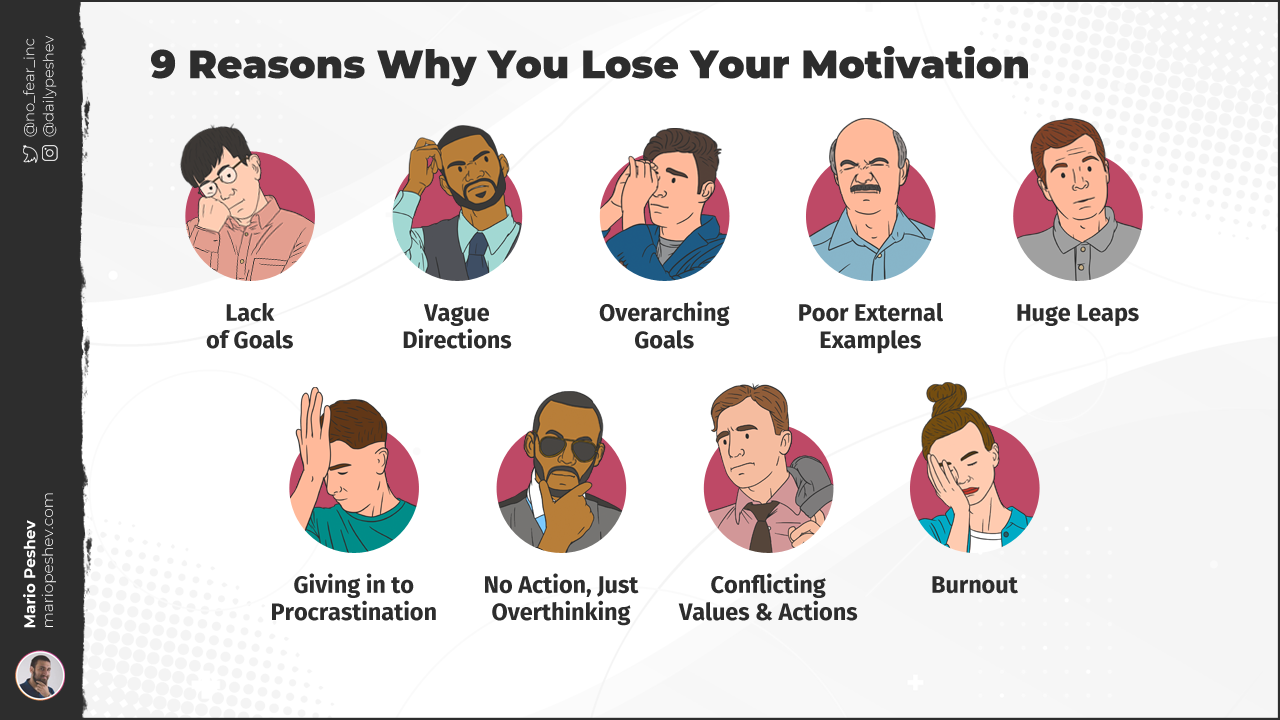According to a Gallup survey called “State of the Global Workplace“, 85% of all employees are disengaged and feel unmotivated at work.
At a macro level, the reason this stat alone is frightening is the life cycle of an individual and the impact on the next generation. Following the same path, a disengaged employee is more likely to:
- Contribute less at work (and barely move the needle unless really needed)
- Report higher risks of mental illness or other mental and psychological issues
- Translate work problems into personal ones, affecting friends and family
- Generally participate in more conversations and preaching the cause of merely working to pay the bills, the capitalistic society, crappy bosses, etc.
- Raise their younger acquaintances, relatives, and kids in a similar environment
- Contribute to the next generation of disengaged workers opposing the concept of work in the first place
Imagine if, instead, half of the 85% were actively invested in learning the skills needed to get a promotion, double down on what works, seek career coaching online—or even merely start with turning their value map toward the road of intrinsic motivation.
In this guide, we’ll discuss motivation in-depth—what it is, how it works, and how to apply it in your personal and professional lives.
- What is Motivation?
- Intrinsic vs. Extrinsic Motivation
- How to Get Motivated
- 1. Start With A Single Goal
- 2. Build Your Value Map
- 3. Create a Dream List
- 4. Implement The 25/5 Rule
- 5. Set Actionable Goals
- 6. Break Them Into Milestones
- 7. Don't Break The Chain
- 8. Gamify The Experience
- 9. Join a Community
- 10. Find Your Role Models
- 11. Document Your Journey
- 12. Keep Your Health In Check
- 13. Fake It 'Till You Make It
- How to Stay Motivated
- Common Motivation Blockers
- Get Motivated to Work
- Manage Your Chores (Like a Boss)
What is Motivation?
Motivation is the desire to do something. The inner drive encourages someone to take action and achieve a goal.
In a nutshell, it’s the driving force toward accomplishing goals. Without motivation, you can’t effectively complete milestones, move with the right velocity level, and enjoy the journey on the way.
Motivation is comprised of numerous factors derived from your own values, the surrounding environment, biological and emotional triggers, considerations of your social circle, cognitive functions, and even your physical preparedness to undertake new challenges.
By cultivating a supportive environment, adopting a growth mindset, and tapping into personal passions, individuals can fuel their inner drive to embrace challenges, reach milestones, and find joy in life’s journey.
Understanding and harnessing the different forms of motivation can lead to more fulfilling and sustainable accomplishments.
There are two types of motivation: intrinsic motivation and extrinsic motivation. Intrinsic motivation comes from within, while extrinsic motivation comes from external factors.
Intrinsic vs. Extrinsic Motivation
- Intrinsic motivation is driven by internal factors such as enjoyment, interest, or satisfaction. People who are intrinsically motivated are self-motivated and don’t need external rewards to be motivated. Intrinsically motivated people are drawn to tasks and activities for their own sake rather than because they want external rewards like money or fame. They often find pleasure in challenging themselves and mastering new skills.
- Extrinsic motivation is driven by external factors such as money, fame, or power. People who are extrinsically motivated are motivated by rewards that come from outside themselves. Extrinsically motivated people often do things for the sake of others rather than for their own enjoyment. They may be more likely to take risks in order to achieve their goals.
Intrinsic motivation and extrinsic motivation work differently in the brain. Intrinsic motivation comes from within the individual, while extrinsic motivation comes from external factors.
Both intrinsic and extrinsic motivation activate different parts of the brain. Leveraging triggers across both spectrums will yield better results over time. Extrinsic motivation can provide a quick short-term boost and enable you to get started sooner – but successfully turning a habit into a lifestyle is contingent on your intrinsic motivation.
How to Get Motivated
Here’s how to increase your motivation overall—with several simple-to-follow steps around goal-setting and growing engagement.

1. Start With A Single Goal
The biggest mistake when undertaking a new activity is “overdoing it”. No matter if it’s a new skill, working out, getting motivated…
Start small and incrementally grow once you get the grip of it.
So instead of kicking this off with a New Year’s resolutions list – pick ONE goal that you care about first. Prioritize it and obsess about it – and traction will follow.
2. Build Your Value Map
While preparing for the next hills to climb, set some time aside to work on your value map.
We talked about intrinsic motivation earlier – it’s time to put this into action.
Answer the following questions:
- What do I deeply care about in the world – always have, always will?
- If I need to spend the next 10 years learning/doing/training something, what would it be?
- What are the core activities I genuinely care about?
- What do I want to be remembered with when I grow old?
- What is the main positive trait my closest peers would label me with?
- What are the core values I assess the people closest to me with?
- What are the positive lessons I admire my idols for?
- What are the examples I want to inspire people around me with?
- If I was to write an autobiography in the future, what does the right journey look like?
You can expand on this framework, but the goal is to find out what drives you permanently, what the ideal “You” looks like in the future, and what it takes to get there.
Any habits you build should support the goal. This symbiosis between what you do and where you want to go is key to maintaining motivation over time.
3. Create a Dream List
Once you have your values in order, create a dream list of goals you want to achieve to get there.
Don’t be afraid of aiming high – determination and perseverance can take you anywhere if you really want it, and align your entire life around your dreams.
Boost your creative juices and prepare the list. What do you want to look like? What sports do you want to ace? Eager to speak a new language fluently? Spent a year working from Thailand? Own a house with an outdoor pool?
Create your dream list this week.
4. Implement The 25/5 Rule
Warren Buffet came up with this rule a decade ago, even though it was debunked at the end. It doesn’t make the technique any less valid for goal setting, so here’s how it work.
Take the top 25 dreams from your list – and start ranking them by importance or priority. You need to end up with 5 goals you truly care about – endeavors you want to pursue “no matter what” over the next 3, 5, 10 years.
Some may be easier to achieve while others are more ambitious. But aiming for an endless bucket list is not sustainable – it will end up being a hit-or-miss wishlist that does not contribute to the bottom line.
Outlining the 5 areas you truly want to succeed in is the key. Refine your list and let it be your mission in life.
5. Set Actionable Goals
Visualization is a powerful skill. World leaders swear by this technique, and so do many of the leading athletes and actors in the world.
Reverse-engineer your 5 Dreams list. How do you get there?
Goals can be broken down into learning courses, training sessions, adapting your sleeping habits, and making permanent life choices to accommodate to that change.
If you want to become a great surfer while living away from the ocean, you need to plan your holiday schedule for the coming years in a way that supports that mission. Or plan to move closer to the ocean in the next 2 years and take it from there.
Whatever the goals are – if this is your dream list supporting your value map – create a comprehensive plan for each goal. Make sure that your goals are compatible – for instance, you can’t be a 300 pounds powerlifter while acing gymnastics which is contrarian in a body composition way.
6. Break Them Into Milestones
Set some milestones for your plan.
If you want to ace Mandarin, you need to start to take classes and supplement with apps like Duolingo. You likely need to join a Mandarin-speaking community or spend a few months in China.
This is a long-term goal – and it’s contingent on excellent planning and visualizing every step of the journey.
Post this list publicly. Add it to your calendar. Make it SMART – simple, measurable, achievable, relevant, and time-bound. What gets measured, gets managed.
7. Don’t Break The Chain
Jerry Seinfeld’s productivity rule, known as “Don’t break the chain”, is actually among my favorite productivity frameworks and it’s all about taking one step at a time—consistently. If you have classes twice a week, hit them. If you work out 3 or 4 times a week, make it happen.
Buy yourself a calendar and stick it to your wall. Cross every tick and make sure you stay consistent. The more traction you get, the harder it is to break the chain and start all over.
8. Gamify The Experience
Treat yourself upon completing some milestones. You deserve it!
A decade ago, when I crossed 100kg (220 pounds), I set a plan to drop back to 83kg (183 pounds) as soon as possible. I did not allow myself to consume any sugar or fast food until I crossed 50% of my goal. It was a tempting exercise to fast-pace the goal, get to the point where I can reward myself, and continuously push further, avoiding another “lockdown” of my favorite snacks.
You can set some waypoints on the way—say, a bowl of ice cream after every 12 heavy workout sessions, or a weekend getaway once you complete a level in your language course.
9. Join a Community
“You are the average of the 5 people you spend the most time with.”
If you want to succeed, surround yourself with the right people.
I’ve been working out out on-and-off since high school, but the only time I built a proper habit was when I joined the local CrossFit community. This entailed group sessions with the coaches, participating in competitions, following and praising one another on social media, and fat-shaming ourselves after binge eating sessions.
It’s the type of culture that keeps you on track, pushes you past the limits, and gets you closer to your goals.
10. Find Your Role Models
Tap into your local community. Browse mentors, influencers, or coaches online. Read and watch everything they have produced to date (including interviews, conference talks, sessions).
Look into your own network as well—friends, family, colleagues.
Vishen Lakhiani of Mindvalley has uncovered his journey to becoming fit and staying fit in his own community. After undertaking sports classes with one of his colleagues, many have followed, and it became a tradition among new hires in the group.
If you want to become a leading content marketer, starting your day with the Marketing School podcast by Neil Patel and Eric Siu is a great kicker to get into writing along with your first cup of coffee.
Following influencers on social media is a good exercise as well. While achieving extra-human shape and strength takes forever, it keeps you on track and gets you closer to the desired results.
11. Document Your Journey
One of the best forms of blogging is documenting one’s journey.
If you’re into writing, start a blog from day one and document your progress. It won’t be a hit from day one, but several years later, you’ll end up influencing tens of thousands of people starting from the same spot—looking for a role model on their own.
Even if you’re not into blogging, create a journal. Progress is slow to track otherwise, but comparing your new self with where you started several months back is relieving—and motivating.
12. Keep Your Health In Check
It doesn’t matter what your goals are—if you aren’t fit and healthy, you’ll have a hard time pushing through.
This covers a broad mix of workouts, sleeping well, changing your dietary habits, increasing your activity time throughout the week—but it’s all for the best.
Influencers, business leaders, athletes all pay attention to their physical, mental, and spiritual health – and so should you.
13. Fake It ‘Till You Make It
It’s easy to give up or kick into imposter syndrome but practice makes perfect.
Take on challenges that seem unbearable like joining a more advanced group or trying to speak a new language while traveling. Yes, you will suck, but you will learn faster and progress faster accordingly.
The reason why motivated juniors excel quickly at work is the vast volumes of knowledge they have to consume on a daily basis. Surround yourself with experienced people in your area of improvement and you will grow faster.
How to Stay Motivated
Maintaining motivation over time is about habits, surrounding yourself with the right people, and appreciating the efforts so far (and the results that are coming through).
Here’s how to move the needle.

1. Create a Routine
Staying motivated is about maintaining progress. Even if you made it through the first few weeks or even months, you can’t rely on ad-hoc life changes.
A common problem in breaking the chain is taking a break for personal reasons— it could be illness, work travel, a long cheat week or two during the holidays.
Creating a sustainable routine that keeps you on track even if you take a week or two off is integral in the grand scheme of things.
2. Force Yourself For (At Least) 3 Months
No matter what you do, the first three months are the most important.
Building a habit takes 21 days in a row. Turning a habit into a lifestyle change takes 90 days (at a minimum).
Unless you push your limits daily, plan for a longer “trial period”—6 months or so.
Actors, athletes, business influencers have spent decades on their craft. You can’t expect to move the needle in a matter of weeks.
Give it time and make permanent changes that reflect your goals. Results will follow and help you push further.
3. Connect With Your Community
Once you’ve made some progress, you should feel more comfortable engaging further with your community.
You’ve probably made some acquaintances on your courses or at the gym. Take it further—plan some study or workout sessions together. Or join a project or a competition as a group.
Teamwork is the best type of work—and a great example that keeps you motivated for prolonged periods of time.
4. Surround Yourself With Positive Examples
You may feel a disconnect between contrarian groups of people you communicate with.
It’s only natural for your family or work colleagues to stick to different regimes (or simply live in different periods of their lives). My goals and aspirations in my early 20s were dramatically different from my 30s and this plays a role as well.
But whatever it takes, don’t let nay-sayers pull you back. Your surroundings should either be aligned with your goals—or at least, supportive.
Take a stand and defend your life choices—and if needed, change your inner circle for the best.
5. Measure Progress Regularly
Your efforts are paying off over time. It’s hard to neglect progress unless you come up with measurable elements to keep you focused.
Startups often rely on scorecards for weekly or monthly measurables. Create a personal scorecard for your journey—number of courses/workout sessions, how many books you read over the past month, your workout PRs or weight you lost.
A common workout caveat is relying on weight alone even if your waist size is shrinking—use the right metrics and monitor your success this way.
6. Refer to Your Value Map
When in doubt, revert back to the Value Map we designed earlier.
Your daily efforts support a certain skill, and this skill is instrumental to achieving goals.
The connection isn’t always obvious and getting back to the root of your goals will get you back on track.
7. Announce It Publicly
Post some photos on social media with your progress to date. Or announce attending a new course or a competition.
Make it public!
You’ve already spent several weeks or months pushing further. You can reward yourself with some positive reinforcement or extra motivation from peers who support you in your journey.
Even earlier goal setting can be motivating. Remember high school reunions—you want to come back smarter, leaner, more successful—and that should keep you up at night.
8. Daily Reminders
Book time on your calendar for the activities that you care about. Don’t let them fit into your schedule—it won’t happen.
If you need to read and study, book an hour every day dedicated to that.
Plan your workout sessions ahead of time and add them to the calendar too. Use morning reminders. Or start your day with a motivational video of successful people in your industry.
9. Hustle Through Tough Times
You can’t plan a 5-year goal and expect it to go smoothly even with the best of intentions. Bumps on the road are expected. But, don’t let them detract you.
Push twice as hard during tough times. If needed, take a week or two to rest. No matter what happens, don’t ever give up on your goals.
I’ve gone through extremely rough times at work, sickness, injuries. Your gym or training center may be closed over the holidays. Working out in the winter is far from ideal. But pushing through is worth it so prioritize it.
10. Focus On The Gains
Cherish the new skills or learnings. Celebrate what you’ve learned.
Memorize it!
Write it on a piece of paper or take a photo of it. Take a look in the morning before a workout session. Hard work pays off—focus on the gains and the rest will follow.
Common Motivation Blockers
Even while trying to follow some basic tips around gaining motivation… This doesn’t always cut it.
“You do not rise to the level of your goals. You fall to the level of your systems.”
James Clear, author of Atomic Habits
Besides your TODO list, you also need a NOT DO one—including the following requirements.

1. Lack of Goals
Lack of purpose—or lack of goals—is a common obstacle for sticking to a habit.
Make sure you follow through with the value map exercises and prepare your dream list with actual milestones in mind.
Just aiming to “keep working out” or “become a better writer” is not a quantifiable goal, lacking measurements and targets to hit.
2. Vague Directions
Lack of clarity in any sense will be a turning block.
Part of the goal-setting exercise is your focus.
Have a clear action plan in place—how often you do what, how do you gauge intensity, how frequently do you test your skills or knowledge.
Design a process that everyone would be able to follow easily.
3. Overarching Goals
Grand goals require an insurmountable level of self-control and focus.
If you want to become a gold medalist in a sport or generate $1M in passive revenue out of nowhere, be prepared for an extraordinary level of commitment.
Either calibrate your goals ahead of time, fully devote yourself to them, or break them down into realistic yet fulfilling milestones along the way.
4. Poor External Examples
The lack of external support, a weak community, or a generally wrong environment can be detrimental to motivation.
If you’re committed to staying fit but your entire group of peers is binging on junk food all the time, the process won’t get any better.
If you want to launch an exciting startup but there are no incubators and accelerators nearby, you won’t get the same level of support.
Either change your environment or work twice as hard to push through.
5. Huge Leaps
Your milestone-setting process should be reasonable. Make it possible to celebrate small wins every few weeks or at least a couple of months.
If your assessment period is annual, it’s easy to fall off track. Practice makes perfect, but maintaining motivation without seeing results for a prolonged period of time won’t make it easier.
6. Giving in To Procrastination
Distractions surround us 24/7. Bar-hopping with friends, Netflix at home, ice cream booths on the way, or pizza stands—it’s 100x easier to find excuses than get the job done.
Declutter your workspace, block time in your calendar, and get it done.
Work with smaller bites at first until you get traction—for instance, start with a 15-minute home workout before a 90-minute gym session or read 5 pages a day instead of one book a week.
7. No Action, Just Overthinking
Some individuals are prone to overengineering processes.
Sharpening the saw is an important habit before taking over the world but make sure you actually devote time to doing the work, too.
I’ve faced this same problem with hundreds of my students over the past 15 years. Reading books and watching training videos is important, but until you get your hands dirty, you’re stuck on level 0.
8. Conflicting Values & Actions
A big red flag is setting goals that contradict your value map.
One really common example is what I call the “Robin Hood” paradox—combining a spiritual goal with a capitalistic journey. Imagine being eager to give back to a monastery or support a yoga group or give back to charity, but having to work on Wallstreet or a casino to make a living.
If possible, try to align your path with your end goal. It’s not always possible but the process will be easier.
9. Burnout
Overachievers can end up burning out.
I have discussed burnouts at the workspace and there are certain nuggets you can implement here, too.
But remember: you need to maintain a consistent velocity, allowing you to get enough sleep and still maintain sanity in the process.
Get Motivated to Work
Intrinsic motivation at work: What is it and how to use it?
As mentioned earlier, intrinsic motivation comes from within a person. It triggers an individual’s passion and desire to engage in activities without external rewards or incentives.
People aim for mastery of skills by learning new things through active engagement and exploration. By doing this, they improve their skills while also maintaining a positive attitude towards the task at hand—regardless of whether those tasks are pleasant or unpleasant.
Intrinsically motivated individuals derive satisfaction from achieving their goals; thus motivating them further into working harder each day as well as pursuing more challenging targets down the road!
Your career should support the direction you are undertaking. Look for the type of job that aligns with your value map. There’s nothing better than working with peers sharing common goals, giving back to society while making a living yourself.
Manage Your Chores (Like a Boss)
I’ve been obsessed with efficiency and yielding high results, and fortunate enough to have assistants around, a cleaning lady at home, and recurring digital purchases to handle misc tasks and activity.
But even if you delegate the vast majority of your responsibilities, there are always “have to do” activities you can’t get without. For some, it’s cleaning or shopping, washing the dishes, driving kids to school, preparing reports, schedule 1-on-1s.
Instead of making a fuss out of them, here’s how to combat the chores (and ace them).
Focus on The Positives
Program yourself to pay special attention to the positives of the exercise. Cleaning gets your workspace decluttered which is great for focus, lack of dust, and your general zen mode.
Shopping helps you get the right ingredients that are good for your health. Cooking means healthier means at a lower cost!
Even paying your taxes is important—you want to pay your dues and tick this off your list, and maybe you can boost your accounting skills on the go.
Tune Up Your Playlist
Whenever possible, combine your chores work with a playlist or an audiobook (or maybe a podcast).
There are different benefits you can derive from mixing them up. I’ve discussed the power of multitasking for additional ideas you can bring to the mix.
Set Timers and Gamify
Try to work out a plan—or even timebox your chores.
Can you wrap up shopping in 30min? This will keep you on track.
If you get it done in 20 minutes, you can reward yourself with an extra fruit salad (or whatever floats your boat, as long as it doesn’t contradict the goals).
Schedule Early On
Set time up for your chores. It may be daunting, but procrastinating and postponing several times doesn’t help either.
Stop procrastinating and mark it on your calendar, then get it done. More time for productive activities later!




